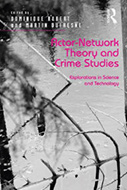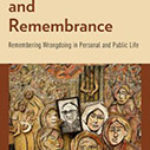Actor-Network Theory and Crime Studies: Explorations in Science and Technology

Authors: Dominique Robert and Martin Dufresne
Publisher: Farnham, UK; Ashgate (Routledge), 2015. 160p.
Reviewer: Wytske van der Wagen | May 2016
It was about time that a criminological volume would appear that is fully dedicated to Actor-Network Theory (ANT) and its potential for crime studies. ANT not only deals with ‘uncertainties’ or ‘issues’ that lie at the heart of many criminological debates (e.g. the agency-structure debate), but also provides several new thought-provoking challenges for criminological scholarship. For example: Can objects too have agency? Do groups exist? Does society exist? What is (‘the’) ‘social’? What is ‘evidence based’? How is criminological knowledge produced? The book aims to address these issues through a collection of various contributions of different sociological and criminological scholars. Unquestionably, to fully capture the (often quite radical and sometimes misunderstood) ideas of ANT and ‘translating’ them to a criminological context can be seen as already an intellectual challenge by itself. The editors and authors successfully took up this challenge and made some significant steps towards placing ANT on the criminological agenda.
The book starts with a preface by Franko-Aas, which presents some of the above challenges, and a short preliminary chapter by the editors. Here Robert and Dufresne specify what ANT has to offer for a (critical) study of crime and crime control. After this, the book presents eight chapters in which we can find different criminological issues and ANT concepts brought together. The main ANT dimensions that are touched upon are: 1) the relational approach (an entity has meaning only in relationship to other entities), 2)combining human and non-human entities (the idea that humans and non-humans both contribute to actions and results) and 3)producing crime facts and science (how scientific facts are created/produced). The book is structured in a logical manner, and the aim of the book, to provide multiple accounts of ANT, is clearly announced in the beginning.
The editors, however, do not include a comprehensive introduction into the basic core assumptions of ANT. On page three, they write: “Let us look beyond the buzzwords traditionally associated with ANT (translation, inscription, etc.) and let us give ANT a chance to irritate, destabilize, and therefore inspire us.” It appears to me that the editors assume that the average reader has some understanding of ANT already while, to my knowledge, for the majority of criminologists this is not the case. By providing some basic insights or a more extensive overview on ANT at the outset, the editors could have used the opportunity to fill this knowledge gap and improve the overall readability and interconnectivity among the various chapters in the book. The book could start for example, by ‘simply’ asking what ANT is and what it is not. Is it a theory, a methodology, a sensitizing approach, an ethnography extended to non-humans? Does it ‘explain’ something? What does the ‘actor, the network and the theory’ in ‘Actor-Network Theory’ stand for and why is there a hyphen placed between the actor and the network? Of course, these are all questions thoroughly discussed in the ANT literature itself, and beyond, but can they be dismissed in a criminological volume that places ANT at the heart of the debate?
In opposition, there is also something to say for not taking this path, and instead making the readers acquainted with ANT throughout the chapters themselves — the approach taken in the volume. Each chapter draws attention to some key notions of ANT relevant for the particular (case)study in question. Arguably, this ‘multiple’ setup has the advantage of presenting ANT in a more playful sort of ‘messy’ and diverse way, and avoids a long (too) theoretical elaboration on ANT that perhaps would run the risk of ‘deterring’ the readers. Definitely, the strong point of the book is that each chapter gives a glimpse on how to apply certain aspects of ANT on a criminological key theme, and also clearly frames and demonstrates what ANT concretely has to offer or to add.
Demant and Dilkes-Frayne discuss in the first chapter how ANT can complement current ideas around Situational Crime Prevention (SCP), and apply this combined framework on two examples of crime prevention in nightlife spaces. Certainly, connecting ANT with SCP seems to be a very worthy match. ANT is interested in how technologies can co-shape, control and/or restrict human action, and SCP strategies are directed to manipulating the direct environment where a potential crime (opportunity) might arise. While both approaches focus on collections of or interactions between humans and non-humans, ANT is able to more thoroughly capture theprocess underlying the central concepts of SCP: crime, opportunities, situations and displacement. The chapter’s argument that ANT is able to theorize and analyze the crime (prevention) process beyond the concept of Rational Choice, I found to be a very valuable contribution to criminology.
Doullet and Dumoulin’s chapter also focusses on the question of how technologies can be important actants in crime control, yet from a rather different angle. They explicitly ask which underlying processes encourage the use of particular CCTV systems. Their choice of using ANT lies in its ‘ability’ to study processes of socio-technical innovation: how/why a certain technology is introduced, which human and non-human (f)actors play a role in (co)shaping this process and what are the effects produced by this technology. The key finding here is that ANT is valuable for public policy analysis, as it also takes the role of objects into account. Perhaps more importantly, ANT is able to unravel or understand unintended policy outcomes by focusing on a broader set of actors and interactions, which were not foreseen by the (intentional) policy makers.
After getting somewhat familiar with ANT’s notions on non-human agency and the importance of taking the role of objects and technology into account, Dufresne’s chapter on biosocial criminology deals with a rather different ANT dimension: the social activity of science itself, and the ‘fabrication’ of scientific propositions. The author makes use of Latour’s and Callon’s work on the translation model of science. What can the ‘sociology of translation’ say about biocriminology, the ‘vulnerability gene hypothesis’ in particular? The chapter can be perceived as a valuable ANT contribution to the notion that scientific ‘facts’ are always produced in a certain social, political and technical or laboratory context – an issue too little reflected upon within (mainstream) criminology.
Likewise, Lam’s fourth chapter embeds ANT very comprehensively in the important criminological key notion that crime is a socially constructed phenomenon. She demonstrates, by examining the “Lucky Moose” case, that criminal justice practices produce multiple objects and realities of crime, something we can only unravel when we appreciate the value of ‘messy findings’. In my opinion, this chapter could actually have been a good chapter to start with in the book, as it situates ANT within or between the main paradigms in criminology.
Moore and Singh’s contribution seeks to place ANT into the framework of feminist (and perhaps also visual) criminology. Rather than viewing violence against women from the realm of the law, these authors focus on violent images, which technologies create them and how such (powerful) images might change the way we ‘see’ such violence. Notably, they do not only address ANT’s view on non-humans, relationality and the ensuing methodology (taking the network as the starting point), but also call upon ANT’s reflexivity of the researcher: the idea that the (ethnographic) researcher is part of the network being researched and brings his or her own baggage to the scene. The case study shows how power relations between researcher and respondent (in this case the victim of the assault) can be mediated by technologies as well (e.g. the camera), hereby adding a new ANT layer to existing feminist and criminological insights.
Mopas starts in chapter six with a critical note on ANT itself by asking: what ANT tells us to do after we open up the ‘black box’ of science and technology – a critique that seems to mirror closely how critical criminologists are viewed regarding their thoughts on the constructed nature of crime. The chapter is however not a critique, but a stimulating ANT inspired essay on how critical and constructivist scholars can move or ‘translate’ their line of thinking (and its subsequent research methods) into public spheres — that the public will also see and appreciate its (scientific) value.
Moreau de Bellaing deals with the question of what so-called tasers (a non-lethal alternative for conventional weapons) do to the police use of force: is it an ‘anti-blunder weapon’ or an instrument leading to the escalation of violence? After describing some pros and cons, ANT is brought to the discussion, a logical step, as Latour specifically addresses the issue of guns in his work. He argues that neither people kill people nor guns kill people, but rather the interaction, i.e. the ‘person-carrying-a weapon association’ is responsible for the action and the result. Looking at weapons and other technologies this way, ANT can shed a different light on such issues – also providing new questions or reformulating existing questions.
Renard’s chapter on the use of genetic analysis for identification in criminal justice uses the combined perspective of ethomethodology and actor-network theory; both (descriptive) approaches that pursue to ‘let the data speak for itself’ and seek to include more actors in the analysis. I found the chapter not only valuable for its description of the processes of DNA analysis in a judicial context, but also for its more extensive explanation of ANT’s key (methodological) notions themselves: who/what produces action, the difference between mediators and intermediaries, translation and the meaning of network for ANT. In that sense, the chapter employs a rather different angle than Robert and Dufresne’s chapter on DNA identification. Those authors place the concept of ‘factish’ central, which touches upon Latour’s notion of ‘matters of fact versus matters of concern’ – whether the distinction between facts and beliefs exists. The central question in this chapter is how scientists explain genetic identification to politicians and whether the two realms (politics and science) can be separated during such process. The chapter provides an inspiring analysis of the socially constructed nature of science itself.
To sum up, the editors and authors succeeded in providing manifold accounts of ANT and demonstrated its value not only theoretically but also empirically. My personal view on what ANT has to offer for criminology is quite well represented in the book: the active treatment of non-humans, the relational and networked nature of the social and the critical/ constructionist lens, which lets us reflect upon the object of study (crime), the criminological researcher and criminology as a science. Looking more thematically, I believe that ANT can be also valuable for cyber criminology, a growing (research) domain where the human/non-human, the virtual and the actual and many other forms of hybridity emerge. It might have been worthwhile to cover this topic in the contributions, but I also understand that not all themes can be addressed in one volume. Finally, I am convinced that the book will inspire many criminologists as well as opening up the road to more criminological ANT-based studies.
Wytske van der Wagen MsC, PhD candidate in Criminology at the University of Groningen, The Netherlands


